
Filgotinib
- C21H23N5O3S
- MW425.504
- Elemental Analysis: C, 59.28; H, 5.45; N, 16.46; O, 11.28; S, 7.54
1206161-97-8
Cyclopropanecarboxamide, N-[5-[4-[(1,1-dioxido-4-thiomorpholinyl)methyl]phenyl][1,2,4]triazolo[1,5-a]pyridin-2-yl]-
G146034
GLPG0634
N-(5-(4-((1,1-dioxidothiomorpholino)methyl)phenyl)-[1,2,4]triazolo[1,5-a]pyridin-2-yl)cyclopropanecarboxamide
IL-6 antagonist; Jak1 tyrosine kinase inhibitor; Tyk2 tyrosine kinase
inhibitor; Jak3 tyrosine kinase inhibitor; Jak2 tyrosine kinase
inhibitor
Autoimmune disease; Cancer; Colitis; Crohns disease; Inflammatory disease; Neoplasm; Rheumatoid arthritis; Transplant rejection
Filgotinib (GLPG0634), by the
Belgian biotech company
Galápagos NV, is a
drug which is currently under investigation for the treatment of
rheumatoid arthritis and
Crohn’s disease.
Filgotinib (GLPG0634) is an orally-available, selective inhibitor of
JAK1 (Janus kinase 1) for the treatment of rheumatoid arthritis and
potentially other inflammatory diseases. Filgotinib (GLPG0634)
dose-dependently inhibited Th1 and Th2 differentiation and to a lesser
extent the differentiation of Th17 cells in vitro. GLPG0634 was well
exposed in rodents upon oral dosing, and exposure levels correlated with
repression of Mx2 expression in leukocytes. The JAK1 selective
inhibitor GLPG0634 (Filgotinib) is a promising novel therapeutic with
potential for oral treatment of rheumatoid arthritis and possibly other
immune-inflammatory diseases. Filgotinib (GLPG0634) is currently in a
Phase 2 study in Crohn’s disease.

3D
Mechanism of action
Filgotinib is a
Janus kinase inhibitor with selectivity for subtype
JAK1 of this enzyme. It is considered a promising agent as it inhibits JAK1 selectively. Less selective JAK inhibitors (e.g.
tofacitinib)
are already being marketed. They show long-term efficacy in the
treatment of various inflammatory diseases. However, their lack of
selectivity leads to dose-limiting side effects.
[1] It
is thought that inhibition of all JAK isoenzymes is beneficial in
rheumatoid arthritis. However, pan-JAK inhibition might also lead to
unwanted side effects that might not outweigh its benefits. This is the
rationale for the development of newer and more selective inhibitors
like filgotinib.
The signal transmission of large numbers of
proinflammatory cytokines is
dependent on JAK1. Inhibition of JAK2 may also contribute to the
efficacy against RA. Nonetheless it is thought that JAK2 inhibition
might lead to
anemia and
thrombopenia by interference with
erythropoietin and
thrombopoietin and
granulocyte-macrophage colony-stimulating factor.
Therefore one might prefer to choose a more selective JAK1 inhibitor as
a primary therapeutic option. Filgotinib exerts a 30-fold selectivity
for JAK1 compared to JAK2.
[2] It is however still to be seen to what extent JAK2 inhibition should be avoided.
Novel crystalline forms of filgotinib salts, particularly
hydrochloride salt, useful for treating JAK-mediated diseases eg
inflammatory diseases, autoimmune diseases, proliferative diseases,
allergy and transplant rejection. Galapagos and licensee AbbVie are
developing filgotinib, a selective JAK-1 inhibitor, for treating
rheumatoid arthritis (RA) and Crohn’s disease (CD). In August 2015, the
drug was reported to be in phase 2 clinical development for treating RA
and CD. The drug is also being investigated for the treatment of colitis
and was discovered as part of the company’s arthritis alliance with
GSK; however in August 2010 Galapagos reacquired the full rights. See
WO2013189771, claiming use of filgotinib analog for treating
inflammatory diseases. Also see WO2010010190 (co-assigned with GSK and
Abbott) and WO2010149769 (assigned to Galapagos) claiming filgotinib,
generically and specifically, respectively.
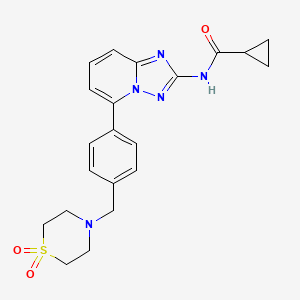
Clinical trials and approval
The efficacy of filgotinib is currently studied in a
phase2b program (DARWIN trial 1, 2) with involvement of 886 rheumatoid arthritis patients and 180 Crohn’s disease patients.
Phase 1 study
It was shown in phase 1 studies that the
pharmacokinetics of filgotinib metabolism is independent of hepatic
CYP450 enzymatic degradation. The drug metabolism is however mediated by
carboxylesterases. There is no interference reported with the metabolism of
methotrexate nor with any of the investigated transport proteins.
[3]
Phase 2 study: Proof of concept (2011)
In november 2011 Galápagos released the results of their phase 2
study (identification: NCT01384422, Eudract: 2010-022953-40) in which 36
patients were treated who showed a suboptimal clinical response to
methotrexate treatment.
Three groups of twelve patients were treated either with 200 mg
filgotinib in a single dose, 200 mg divided in two doses or placebo. The
primary end-point was the
ACR20 score,
which monitors improvements in the symptomatology of the patient. After
the scheduled 4 weeks of treatment, 83% of the respondents showed an
improved ACR20-score. Half of the treated patients showed a complete (or
near complete) remission of the disease. There were no reports of
anemia nor
changes in lipidemia. The company stated in their press release that
filgotinib is the first selective JAK1 inhibitor that shows clinical
efficacy. As a result of this study, the company stated that “GLPG0634
shows one of the highest initial response rates ever reported for
rheumatoid arthritis treatments”.
[4]
DARWIN 1 trial
The DARWIN 1 trial is a 24 week
double blind placebo-controlled trial
with 599 rheumatoid arthritis patients enrolled. All participants have
moderate to severe RA and showed an insufficient response to standard
methotrexate treatment.
The trial compares three dosages of filgotinib as a once or twice per
day regimen. During the trial all participants remain on their
methotrexate treatment. According to the company, the results of this
trial are expected in July 2015.
[5]
DARWIN 2 trial
The DARWIN 2 trial is a double blind placebo-controlled trial with
280 rheumatoid arthritis patients enrolled who show an insufficient
response to standard methotrexate treatment. This trial, in contrast to
the previous DARWIN 1 trial, methotrexate is discontinued. Therefore,
this trial investigates filgotinib as a monotherapy.
[6] The recruitment of DARWIN trial 2b ended in november 2014.
[7] Preliminary
results are expected in the second quarter of 2015 and a full
completion of the study is expected in the third quarter of 2015.
DARWIN 3 trial
Patients who complete DARWIN 1 and 2 will be eligible for DARWIN 3.
Time line
- june 2011: results of first phase 2 trial
- november 2014: initiation of DARWIN 1 and 2 trials
- april 2015: expected date of DARWIN 1 trial results
- june 2015: expected date of DARWIN 2 trial results
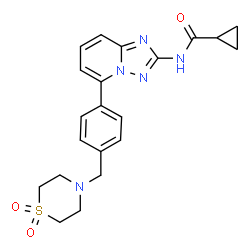
CHEMIETEK
…………
PATENT
http://www.google.com/patents/WO2010149769A1?cl=en
Step 3:
[00131] Cyclopropanecarboxylic acid [5-(4-bromomethyl-phenyl)-[l,2,4]triazolo[l,5-a]pyridin-
2-yl]-amide (leq) and DIPEA (2 eq) were dissolved in DCM/MeOH (5:1 v:v) under N
2 and
thiomorpholine 1,1 -dioxide (1.1 eq) was added dropwise. The resulting
solution was stirred at room temperature for 16h. After this time, the
reaction was complete. The solvent was evaporated. The compound was
dissolved in DCM, washed with water and dried over anhyd. MgSO^ Organic
layers were filtered and evaporated. The final compound was isolated by
column chromatography using EtOAc to afford the desired product.
………..
PATENT
US2010/331319 A1, ; Page/Page column 13-14
http://www.google.com/patents/US20100331319
Synthetic Preparation of the Compound of the Invention and Comparative Examples
The compound of the invention and the comparative examples can be produced according to the following scheme.
wherein Ar represents phenyl-L1-heterocycloalkyl, where L1 is a bond, —CH2— or —CO— and the heterocycloalkyl group is optionally substituted.
General 1.1.1 1-(6-Bromo-pyridin-2-yl)-3-carboethoxy-thiourea (2)
To a solution of 2-amino-6-bromopyridine (1) (253.8 g,
1.467 mol) in DCM (2.5 L) cooled to 5° C. is added ethoxycarbonyl
isothiocyanate (173.0 mL, 1.467 mol) dropwise over 15 min. The reaction
mixture is then allowed to warm to room temp. (20° C.) and stirred for
16 h. Evaporation in vacuo gives a solid which may be collected by
filtration, thoroughly washed with petrol (3×600 mL) and air-dried to
afford (2). The thiourea may be used as such for the next step without
any purification. 1H (400 MHz, CDCl3) δ 12.03 (1H,
br s, NH), 8.81 (1H, d, J=7.8 Hz, H-3), 8.15 (1H, br s, NH), 7.60 (1H,
t, J=8.0 Hz, H-4), 7.32 (1H, dd, J 7.7 and 0.6 Hz, H-5), 4.31 (2H, q, J
7.1 Hz, CH2), 1.35 (3H, t, J 7.1 Hz, CH3).
1.1.2 5-Bromo-[1,2,4]triazolo[1,5-a]pyridin-2-ylamine (3)

To a suspension of hydroxylamine hydrochloride (101.8 g,
1.465 mol) in EtOH/MeOH (1:1, 900 mL) is added N,N-diisopropylethylamine
(145.3 mL, 0.879 mol) and the mixture is stirred at room temp. (20° C.)
for 1 h. 1-(6-Bromo-pyridin-2-yl)-3-carboethoxy-thiourea (2) (89.0 g,
0.293 mol) is then added and the mixture slowly heated to reflux (Note:
bleach scrubber is required to quench H2S evolved). After 3 h
at reflux, the mixture is allowed to cool and filtered to collect the
precipitated solid. Further product is collected by evaporation in vacuo
of the filtrate, addition of H2O (250 mL) and filtration. The combined solids are washed successively with H2O (250 mL), EtOH/MeOH (1:1, 250 mL) and Et2O
(250 mL) then dried in vacuo to afford the triazolopyridine derivative
(3) as a solid. The compound may be used as such for the next step
without any purification. 1H (400 MHz, DMSO-d6) δ 7.43-7.34 (2H, m, 2×aromatic-H), 7.24 (1H, dd, J 6.8 and 1.8 Hz, aromatic-H), 6.30 (2H, br, NH2); m/z 213/215 (1:1, M+H+, 100%).
1.1.3 General Procedure for Mono-Acylation to Afford Intermediate (4)
To a solution of the 2-amino-triazolopyridine (3) (7.10 g, 33.3 mmol) in dry CH3CN (150 mL) at 5° C. is added Et3N
(11.6 mL, 83.3 mmol) followed by cyclopropanecarbonyl chloride (83.3
mmol). The reaction mixture is then allowed to warm to ambient
temperature and stirred until all starting material (3) is consumed. If
required, further Et3N (4.64 mL, 33.3 mmol) and
cyclopropanecarbonyl chloride (33.3 mmol) is added to ensure complete
reaction. Following solvent evaporation in vacuo the resultant residue
is treated with 7 N methanolic ammonia solution (50 mL) and stirred at
ambient temp. (for 1-16 h) to hydrolyse any bis-acylated product.
Product isolation is made by removal of volatiles in vacuo followed by
trituration with Et2O (50 mL). The solids are collected by filtration, washed with H2O (2×50 mL), acetone (50 mL) and Et2O (50 mL), then dried in vacuo to give the required bromo intermediate (4).
Method A Preparation of Compounds of the Invention Via Suzuki Coupling (5):
An appropriate boronic acid (2 eq.) is added to a solution of bromo intermediate (4) in 1,4-dioxane/water (5:1). K2CO3 (2 eq.) and PdCl2dppf
(5%) are added to the solution. The resulting mixture is then heated in
a microwave at 140° C. for 30 min (this reaction can also be carried
out by traditional heating in an oil bath at 90° C. for 16 h under N2). Water is added and the solution is extracted with ethyl acetate. The organic layers are dried over anhyd. MgSO4 and
evaporated in vacuo. The final compound is obtained after purification
by flash chromatography or preparative HPLC. HPLC: Waters XBridge Prep
C18 5 μm ODB 19 mm ID×100 mm L (Part No. 186002978). All the methods are
using MeCN/H2O gradients. H2O contains either 0.1% TFA or 0.1% NH3.
Method B
B1. 4 4-[2-(Cyclopropanecarbonyl-amino)-[1,2,4]triazolo[1,5-a]pyridin-5-yl]-benzoyl chloride
2 Drops of DMF are added to a solution of
4-[2-(cyclopropanecarbonyl-amino)-[1,2,4]triazolo[1,5-a]pyridin-5-yl]-benzoic
acid (1 eq) obtained by Method A using 4-carboxyphenylboronic acid in
DCM under N2 atmosphere. Then oxalyl chloride (2 eq) is added
dropwise to this resulting solution (gas release). The mixture is
stirred at room temperature for 2 hours. After completion of the
reaction by LCMS, the solvent is removed. The crude acid chloride is
used without further purification in next step.
B2. Amide Formation (General Method)
An appropriate amine (1.1 eq) and Et3N (5 eq) are dissolved in DCM under N2 atmosphere
and cooled at 0° C. The acid chloride (B1, 1 eq) dissolved in DCM is
added dropwise to this solution. The reaction is stirred at room
temperature for 16 h. After this time, reaction is complete. The
compound is extracted with EtOAc and water, washed with brine and dried
over anhyd. MgSO4. Organic layers are filtered and
evaporated. The final compound is isolated by preparative HPLC.
Preparative HPLC: Waters XBridge Prep C18 5 μm ODB 19 mm ID×100 mm L
(Part No. 186002978). All the methods are using MeCN/H2O gradients. H2O contains either 0.1% TFA or 0.1% NH3.
…
Synthesis of the Compound of the Invention and Comparative Examples Compound 1 (the Compound of the Invention) Step 1:
2-(4-Bromomethyl-phenyl)-4,4,5,5-tetramethyl-[1,3,2]dioxaborolane
(1 eq) and DIPEA (2 eq) were dissolved in DCM/MeOH (5:1 v:v) under N2 and
thiomorpholine 1,1-dioxide (2 eq) was added portionwise. The resulting
solution was stirred at room temperature for 16 h. After this time, the
reaction was complete. The solvent was evaporated. The compound was
extracted with EtOAc and water, washed with brine and dried over anhyd.
MgSO4. Organic layers were filtered and evaporated. The final compound was isolated without further purification.
STEP 2: Suzuki coupling
4-[4-(4,4,5,5-Tetramethyl-[1,3,2]dioxaborolan-2-yl)-benzyl]-thiomorpholine-1,1-dioxide
(1.1 eq.) was added to a solution of cyclopropanecarboxylic acid
(5-bromo-[1,2,4]triazolo[1,5-a]pyridin-2-yl)-amide in 1,4-dioxane/water
(4:1). K2CO3 (2 eq.) and PdCl2dppf (0.03 eq.) were added to the solution. The resulting mixture was then heated in an oil bath at 90° C. for 16 h under N2. Water was added and the solution was extracted with ethyl acetate. The organic layers were dried over anhyd. MgSO4 and evaporated in vacuo. The final compound was obtained after purification by flash chromatography.
Alternatively, after completion of the reaction, a
palladium scavenger such as 1,2-bis(diphenylphosphino)ethane, is added,
the reaction mixture is allowed to cooled down and a filtration is
performed. The filter cake is reslurried in a suitable solvent (e.g.
acetone), the solid is separated by filtration, washed with more
acetone, and dried. The resulting solid is resuspended in water, aqueous
HCl is added, and after stirring at RT, the resulting solution is
filtered on celite (Celpure P300). Aqueous NaOH is then added to the
filtrate, and the resulting suspension is stirred at RT, the solid is
separated by filtration, washed with water and dried by suction. Finally
the cake is re-solubilised in a mixture of THF/H2O, treated
with a palladium scavenger (e.g. SMOPEX 234) at 50° C., the suspension
is filtered, the organic solvents are removed by evaporation, and the
resulting slurry is washed with water and methanol, dried and sieved, to
obtain the title compound as a free base.
Alternative Route to Compound 1 (the Compound of the Invention): Step 1:
4-(Hydroxymethyl)phenylboronic acid (1.1 eq.) was added
to a solution of cyclopropanecarboxylic acid
(5-bromo-[1,2,4]triazolo[1,5-a]pyridin-2-yl)-amide in 1,4-dioxane/water
(4:1). K2CO3 (2 eq.) and PdCl2dppf (0.03 eq.) were added to the solution. The resulting mixture was then heated in an oil bath at 90° C. for 16 h under N2. Water was added and the solution was extracted with ethyl acetate. The organic layers were dried over anhyd. MgSO4 and evaporated in vacuo. The resulting mixture was used without further purification.
Step 2:
To a solution of cyclopropanecarboxylic acid
[5-(4-hydroxymethyl-phenyl)-[1,2,4]triazolo[1,5-a]pyridin-2-yl]-amide
(1.0 eq) in chloroform was slowly added phosphorus tribromide (1.0
equiv.). The reaction mixture was stirred at room temperature for 20
hours, quenched with ice and water (20 mL) and extracted with
dichloromethane. The organic layer was dried over anhyd. MgSO4,
filtered and concentrated to dryness. The resulting white residue was
triturated in dichloromethane/diethyl ether 2:1 to afford the expected
product as a white solid.
Step 3:
Cyclopropanecarboxylic acid
[5-(4-bromomethyl-phenyl)-[1,2,4]triazolo[1,5-a]pyridin-2-yl]-amide (1
eq) and DIPEA (2 eq) were dissolved in DCM/MeOH (5:1 v:v) under N2 and
thiomorpholine 1,1-dioxide (1.1 eq) was added dropwise. The resulting
solution was stirred at room temperature for 16 h. After this time, the
reaction was complete. The solvent was evaporated. The compound was
dissolved in DCM, washed with water and dried over anhyd. MgSO4.
Organic layers were filtered and evaporated. The final compound was
isolated by column chromatography using EtOAc to afford the desired
product.
…………………….
PATENT
WO 2015117981
Novel salts and pharmaceutical compositions thereof for the treatment of inflammatory disorders
Also claims a method for preparing filgotinib hydrochloride
trihydrate. The present filing forms a pair with this week’s filing,
WO2015117980, claiming a tablet composition comprising filgotinib
hydrochloride.
The compound cyclopropanecarboxylic acid
{5-[4-(l,l-dioxo-thiomorpholin-4-ylmethyl)-phenyl]-[l,2,4]triazolo[l,5-a]pyridin-2-yl
-amide (Compound 1), which has the chemical structure:

is disclosed in our earlier application WO 2010/149769 (Menet C. J.,
2010) as being an inhibitor of JAK and as being useful in the treatment
of inflammatory conditions, autoimmune diseases, proliferative diseases,
allergy, transplant rejection, diseases involving impairment of
cartilage turnover, congenital cartilage malformations, and/or diseases
associated with hypersecretion of IL6 or interferons. Hereafter this
compound is named Compound 1. The data presented in WO 2010/149769
demonstrate that despite similar in vitro activities, Compound 1 has
unexpectedly high in vivo potency compared with structurally similar
compounds.
Example 1. Preparation of Compound 1
1.1. Route 1
1.1.1. 4-[4-(4,4,5,5-Tetramethyl-[l,3,2]dioxaborolan-2-yl)-benzyl]-thiomorpholine-l,l-dioxide

[00205]
2-(4-Bromomethyl-phenyl)-4,4,5,5-tetramethyl-[l,3,2]dioxaborolane (1 eq)
and DIPEA (2 eq) are dissolved in DCM/MeOH (5:1 v:v) under N
2 and
thiomorpholine 1,1 -dioxide (2 eq) is added portionwise. The resulting
solution is stirred at room temperature for 16h. After this time, the
reaction is complete. The solvent is evaporated. The compound is
extracted with EtOAc and water, washed with brine and dried over
anhydrous MgSO i. Organic layers are filtered and evaporated. The final
compound is isolated without further purification.
1.1.2. Cyclopropanecarboxylic acid (5-bromo-[l,2,4]triazolo[l,5-a]pyridin-2-yl)-amide

1.1.2.1. Step i): l-(6-Bromo-pyridin-2-yl)-3-carboethoxy-thiourea
[00206] To a solution of 2-amino-6-bromopyridine (1) (253.8 g, 1.467
mol) in DCM (2.5 L) cooled to 5°C is added ethoxycarbonyl isothiocyanate
(173.0 mL, 1.467 mol) dropwise over 15 min. The reaction
mixture is then allowed to warm to room temp. (20 °C) and stirred for
16 h. Evaporation in vacuo gives a solid which may be collected by
filtration, thoroughly washed with petrol (3 x 600 niL) and air-dried to
afford the desired product. The thiourea may be used as such for the
next step without any purification.
lH (400 MHz, CDC1
3) δ 12.03 (1H, br s), 8.81 (1H, d), 8.15 (1H, br s), 7.60 (1H, t), 7.32 (1H, dd), 4.31 (2H, q), 1.35 (3H, t).
1.1.2.2. Step ii): 5-Bromo-[l,2,4]triazolo[l,5-a]pyridin-2-ylamine
[00207] To a suspension of hydroxylamine hydrochloride (101.8 g,
1.465 mol) in EtOH/MeOH (1 : 1, 900 mL) is added
NN-diisopropylethylamine (145.3 mL, 0.879 mol) and the mixture is
stirred at room temp. (20 °C) for 1 h.
l-(6-Bromo-pyridin-2-yl)-3-carboethoxy-thiourea (2) (89.0 g, 0.293 mol)
is then added and the mixture slowly heated to reflux (Note: bleach
scrubber is required to quench H
2S evolved). After 3h at
reflux, the mixture is allowed to cool and filtered to collect the
precipitated solid. Further product is collected by evaporation in vacuo
of the filtrate, addition of H
20 (250 mL) and filtration. The combined solids are washed successively with H
20 (250 mL), EtOH/MeOH (1 : 1, 250 mL) and Et
20
(250 mL) then dried in vacuo to afford the triazolopyridine derivative
(3) as a solid. The compound may be used as such for the next step
without any purification.
lH (400 MHz, DMSO-i¼) δ 7.43-7.34 (2H, m, 2 x aromatic-H), 7.24 (1H, dd, J 6.8 and 1.8 Hz, aromatic-H), 6.30 (2H, br, NH
2); m/z 213/215 (1 : 1, M+H
+, 100%).
1.1.2.3. Step Hi): Cyclopropanecarboxylic acid (5-bromo-[l ,2,4]triazolo[l ,5-a]pyridin-2-yl)-amide
[00208] To a solution of the 2-amino-triazolopyridine obtained in the
previous step (7.10 g, 33.3 mmol) in dry MeCN (150 mL) at 5°C is added
Et
3N (11.6 mL, 83.3 mmol) followed by cyclopropanecarbonyl
chloride (83.3 mmol). The reaction mixture is then allowed to warm to
ambient temperature and stirred until all starting material is consumed.
If required, further Et
3N (4.64 mL, 33.3 mmol) and
cyclopropanecarbonyl chloride (33.3 mmol) is added to ensure complete
reaction. Following solvent evaporation in vacuo the resultant residue
is treated with 7 N methanolic ammonia solution (50 mL) and stirred at
ambient temp, (for 1-16 h) to hydro lyse any bis-acylated product.
Product isolation is made by removal of volatiles in vacuo followed by
trituration with Et
20 (50 mL). The solids are collected by filtration, washed with H
20 (2x50mL), acetone (50 mL) and Et
20 (50 mL), then dried in vacuo to give the desired compound.
1.1.3. Compound 1

[00209] 4-[4-(4,4,5,5-Tetramethyl-[l ,3,2]dioxaborolan-2-yl)-benzyl]
hiomoφholine , l -dioxide (l . l eq.) is added to a solution of
cyclopropanecarboxylic acid (5-bromo-[l ,2,4]triazolo[l
,5-a]pyridin-2-yl)-amide in 1 ,4-dioxane/water (4: 1). K
2CO
3 (2
eq.) and PdC^dppf (0.03 eq.) are added to the solution. The resulting
mixture is then heated in an oil bath at 90°C for 16h under N
2. Water is added and the solution is extracted with ethyl acetate. The organic layers are dried over anhydrous MgS0
4 and evaporated in vacuo.
[00210] The final compound is obtained after purification by flash chromatography.
[00211] Alternatively, after completion of the reaction, a palladium
scavenger such as 1 ,2-bis(diphenylphosphino)ethane, is added, the
reaction mixture is allowed to cool down and a filtration is performed.
The filter cake is reslurried in a suitable solvent (e.g. acetone), the
solid is separated by filtration, washed with more acetone, and dried.
The resulting solid is resuspended in water, aqueous HC1 is added, and
after stirring at room temperature, the resulting solution is filtered
on celite (Celpure P300). Aqueous NaOH is then added to the filtrate,
and the resulting suspension is stirred at room temperature, the solid
is separated by filtration, washed with water and dried by suction.
Finally the cake is re-solubilised in a mixture of THF/H
20,
treated with a palladium scavenger (e.g. SMOPEX 234) at 50°C, the
suspension is filtered, the organic solvents are removed by evaporation,
and the resulting slurry is washed with water and methanol, dried and
sieved, to obtain the desired compound as a free base.
1.2. Route 2
1.2.1. Step 1: cyclopropanecarboxylic acid [5-(4-hydroxymethyl-phenyl)-[l,2, 4]triazolo[l, 5- a] pyridin-2-yl] -amide

[00212] 4-(Hydroxymethyl)phenylboronic acid (l . l eq.) is added to a
solution of cyclopropanecarboxylic acid (5-bromo-[l ,2,4]triazolo[l
,5-a]pyridin-2-yl)-amide in 1 ,4-dioxane/water
(4:1). K2CO3 (2 eq.) and PdC^dppf (0.03 eq.) are added to the
solution. The resulting mixture is then heated in an oil bath at 90°C
for 16h under N
2. Water is added and the solution is extracted with ethyl acetate. The organic layers are dried over anhydrous MgS0
4 and evaporated in vacuo. The resulting mixture is used without further purification.
1.2.2. Step 2: Cyclopropanecarboxylic acid [5-(4-bromomethyl-phenyl)-[l,2,4]triazolo[l,5- a Jpyridin-2-ylJ -amide

[00213] To a solution of cyclopropanecarboxylic acid
[5-(4-hydroxymethyl-phenyl)-[l,2,4]triazolo[l,5-a]pyridin-2-yl] -amide
(1.0 eq) in chloroform is slowly added phosphorus tribromide (1.0 eq.).
The reaction mixture is stirred at room temperature for 20 h, quenched
with ice and water (20 mL) and extracted with dichloromethane. The
organic layer is dried over anhydrous MgSO i, filtered and concentrated
to dryness. The resulting white residue is triturated in
dichloromethane/diethyl ether 2:1 to afford the desired product.
1.2.3. Step 3:

[00214] Cyclopropanecarboxylic acid
[5-(4-bromomethyl-phenyl)-[l,2,4]triazolo[l,5-a]pyridin-2-yl]-amide (l
eq) and DIPEA (2 eq) are dissolved in DCM/MeOH (5: 1 v:v) under N
2 and
thiomorpho line 1,1-dioxide (1.1 eq) is added dropwise. The resulting
solution is stirred at room temperature for 16h. After this time, the
reaction is complete. The solvent is evaporated. The compound is
dissolved in DCM, washed with water and dried over anhydrous MgSO i.
Organic layers are filtered and evaporated. The final compound is
isolated by column chromatography using EtOAc to afford the desired
product.
…………………
PATENT
http://www.google.co.in/patents/WO2013189771A1?cl=en
Example 1. Synthesis of the compounds
1.1. Route 1
1.1.1. Synthesis of 5-Bromo-[l,2,4]triazolo[l,5-a]pyridin-2-ylamine (Intermediate 3)
led to 5 °C was added ethoxycarbonyl isothiocyanate (173.0 mL, 1.467
mol) dropwise over 15 min. The reaction mixture was then allowed to warm
to room temp. (20 °C) and stirred for 16 h. Evaporation in vacuo gave a
solid which was collected by filtration, thoroughly washed with petrol
(3×600 mL) and air-dried to afford (2). The thiourea was used as such in
the next step without any purification.
[00157]
lH (400 MHz, CDC1
3) δ 12.03 (IH, br s,
NH), 8.81 (IH, d, J 7.8 Hz, H-3), 8.15 (IH, br s, NH), 7.60 (IH, t, J
8.0 Hz, H-4), 7.32 (IH, dd, J 7.7 and 0.6 Hz, H-5), 4.31 (2H, q, J 7.1
Hz, CH
2), 1.35 (3H, t, J 7.1 Hz, CH
3).
1.1.1.2. 5-Bromo-f 1,2, 4]triazolo[ 1 ,5-a] pyridin-2-ylamine (3)
[00158] To a suspension of hydroxylamine hydrochloride (101.8 g,
1.465 mol) in EtOH/MeOH (1 : 1, 900 mL) was added
NN-diisopropylethylamine (145.3 mL, 0.879 mol) and the mixture was
stirred at room temp. (20 °C) for 1 h.
l-(6-Bromo-pyridin-2-yl)-3-carboethoxy-thiourea (2) (89.0 g, 0.293 mol)
was then added and the mixture slowly heated to reflux (Note: bleach
scrubber was required to quench H
2S evolved). After 3 h at
reflux, the mixture was allowed to cool and filtered to collect the
precipitated solid. Further product was collected by evaporation in
vacuo of the filtrate, addition of H
20 (250 mL) and filtration. The combined solids were washed successively with H
20 (250 mL), EtOH/MeOH (1 : 1, 250 mL) and Et
20
(250 mL) then dried in vacuo to afford the triazolopyridine derivative
(3) as a solid. The compound was used as such in the next step without
any purification.
[00159]
lH (400 MHz, DMSO-i¼) δ 7.43-7.34 (2H, m, 2 x aromatic-H), 7.24 (1H, dd, J 6.8 and 1.8 Hz, aromatic-H), 6.30 (2H, br, NH
2); m/z 213/215 (1 : 1, M+H
+, 100%).
1.1.2. Synthesis of 4-[ 4-(4, 4, 5, 5-Tetramethyl-f 1, 3,2] ‘
dioxaborolan-2-yl) -benzyl] ‘- thiomor holine- 1, 1 -dioxide
(Intermediate 4)
[00160]
2-(4-Bromomethyl-phenyl)-4,4,5,5-tetramethyl-[l,3,2]dioxaborolane (1 eq)
and DIPEA (2 eq) were dissolved in DCM/MeOH (5:1 v:v) under N
2 and
thiomorpholine 1,1 -dioxide (2 eq) was added portion wise. The
resulting solution was stirred at room temperature for 16h. After this
time, the reaction was complete. The solvent was evaporated. The
compound was extracted with EtOAc and water, washed with brine and dried
over anhydrous MgSO i. Organic layers were filtered and evaporated. The
final compound was isolated without further purification.
1.1.3. Synthesis of 5-[4-(l, l-Dioxothiomorpholin-4-ylmethyl)-phenyl]-[l,2,4]triazolo[l,5- a ridin-2-ylamine (Formula I)
[00161]
4-[4-(4,4,5,5-Tetramethyl-[l,3,2]dioxaborolan-2-yl)-benzyl]-thiomorpholine-l,l-dioxide
(l .leq.) was added to a solution of
5-bromo-[l,2,4]triazolo[l,5-a]pyrid in-2-ylamine (4: 1). K
2CO
3 (2
eq.) and PdC^dppf (0.03 eq.) were added to the solution. The resulting
mixture was then heated in an oil bath at 90°C for 16h under N
2.
Water was added and the solution was extracted with ethyl acetate. The
organic layers were dried over anhydrous MgSC>4 and evaporated in
vacuo. The final compound was obtained after purification by flash
chromatography.
[00162]
lH (400 MHz, CDC1
3) δ 7.94-7.92 (d,
2H), 7.52-7.48 (m, 3H), 7.37-7.34 (m, 1H), 7.02-7.00 (m, 1H), 6.00 (d,
2H), 3.76 (d, 2H), 3.15-3.13 (m, 4H), 2.93-2.91 (m, 4H).
[00163] m/z 358.2 (M+H
+, 100%). 1.2. Route 2
1.2.1. Cyclopropanecarboxylic acid {5-[4-(l,
l-dioxo-thiomorpholin-4-ylmethyl)-phenylJ-
[l,2,4]triazolo[l,5-a]pyridin-2-yl}-amide (Formula II)
[00164] The compound according to Formula II may be synthesized according to the procedure described in WO 2010/149769.
1.2.2. Synthesis of 5-[4-(l, l-Dioxothiomorpholin-4-ylmethyl)-phenyl]-[l,2,4]triazolo[l,5- aJpyridin-2-ylamine (Formula I)
[00165] The compound according to Formula I can also be produced by hydrolysis of the compound accor ing to Formula II:

[00166] Hydrochloric acid 30% aq (12.06 kg; 3.9 rel. volumes) was
added to a slurry of the compound according to Formula II (3.45 kg; 1.0
equiv.) in demineralized water (10.0 kg; 3.0 rel. volumes).
Subsequently, a line rinse was performed with demineralized water (3.4
kg; 1.0 rel. volumes). The reaction mixture was heated to 80±5°C for
14.5 h. After completion of the reaction (conversion > 99%>), the
reaction mixture was cooled to 20±5°C. The reaction mixture was diluted
with demineralized water (6.8 kg; 2.0 rel. volumes) and sodium hydroxide
33%> aq (9.52 kg; 3.7 rel volumes) was dosed at such a rate that the
temperature of the reactor contents remained below 35°C. An additional
amount of sodium hydroxide 33%> aq (2.55 kg; 1.0 rel. volumes) was
needed to get the pH > 10. The product was filtered off, washed twice
with demineralized water (1.5 rel. volumes) and dried under vacuum for 1
h, thus yielding the crude compound according to Formula I.
[00167] The crude compound according to Formula I (5.70 kg) was
re-slurried in demineralized water (23.0 kg; 8.5 rel. volumes).
Hydrochloric acid 30%> aq (1.65 kg; 0.7 rel. volumes) and
demineralized water (4.3 kg; 1.6 rel. volumes) were added and the
reaction mixture was stirred at 20±5°C for 45 min. As the compound
according to Formula I was not dissolved completely, the reaction
mixture was stirred at 45±5°C for 1 h. The reaction mixture was filtered
and the residue was washed with demineralized water (2.0 kg 0.75 rel.
volumes). Sodium hydroxide 33%> aq (1.12 kg; 0.6 rel volumes) was
added to the filtrate. An additional amount of sodium hydroxide 33%>
aq (1.01 kg) was needed to get the pH > 10. The resulting reaction
mixture was stirred at 20±5°C for about 3 h. The product was filtered
off, washed twice with demineralized water (4.1 kg; 1.5 rel. volumes),
and twice with methyl tert-butyl ether (MTBE; 3.0 kg; 1.5 rel. volumes)
and dried under vacuum for 15.5 h on the filter. The product was further
dried in a vacuum oven at 40±5°C for 202 h, thus affording the desired
compound according to Formula I.
1H NMR PREDICT
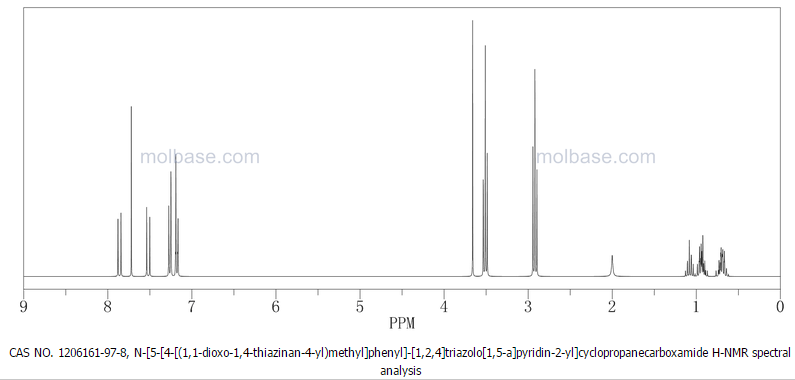
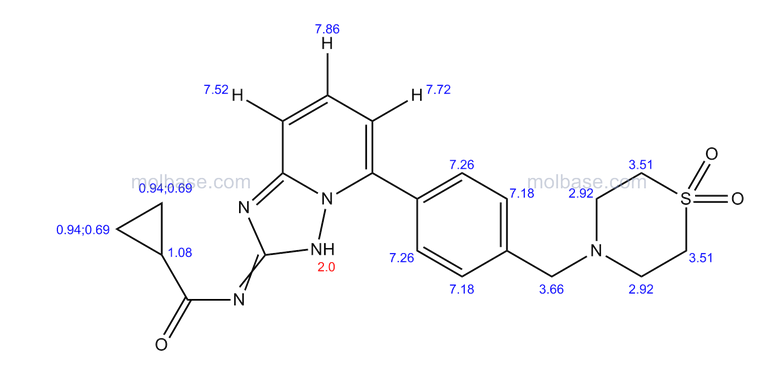
13C NMR PREDICT
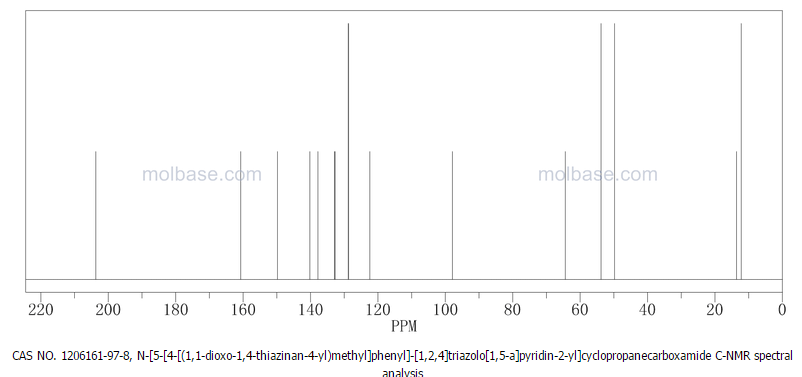
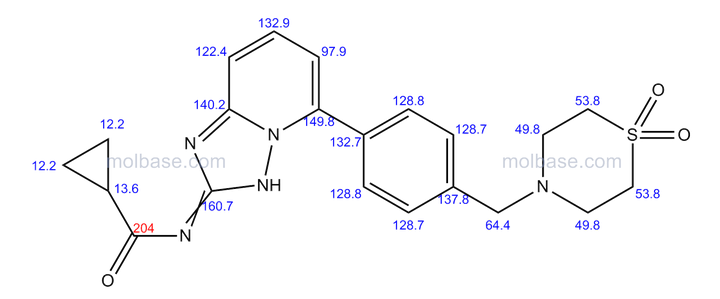
H EXPLODED
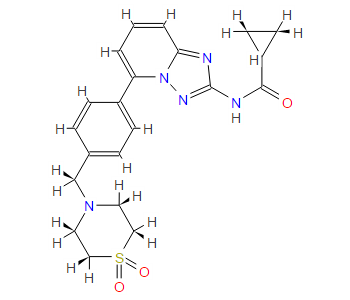
1H NMR FROM NET ABMOLE DMSOD6
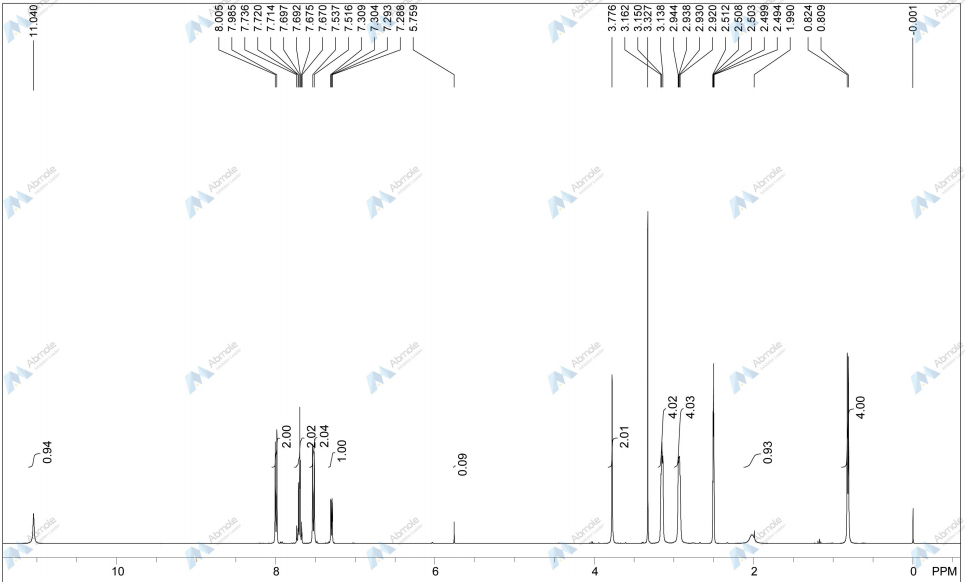
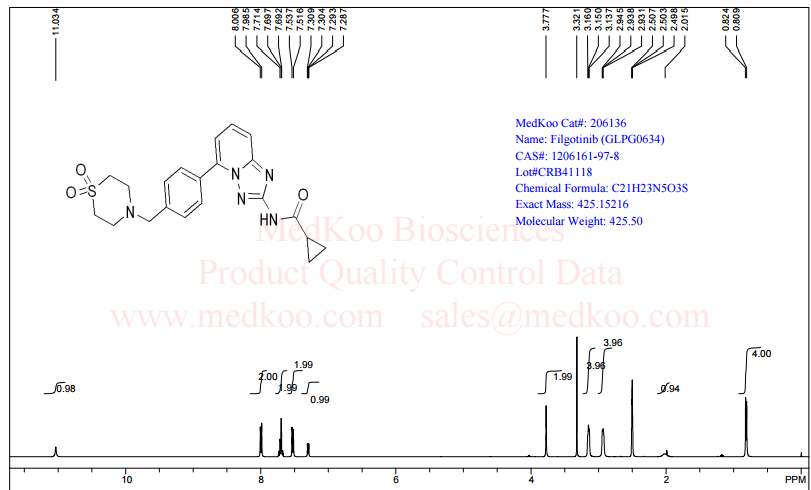
SPECTRAL PREDICT

1H NMR PREDICT

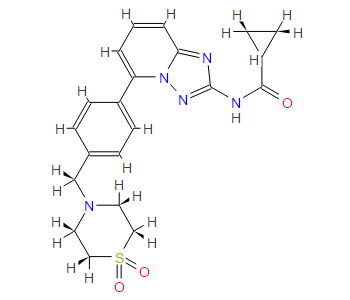
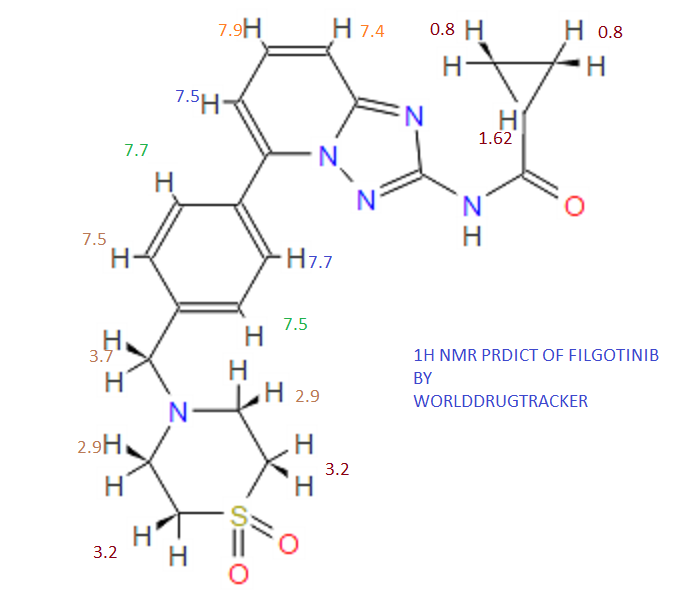
13C NMR PREDICT
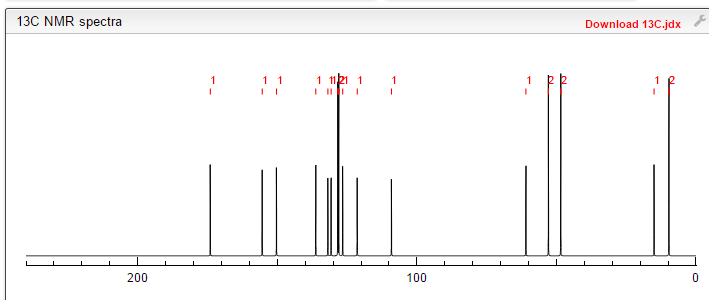
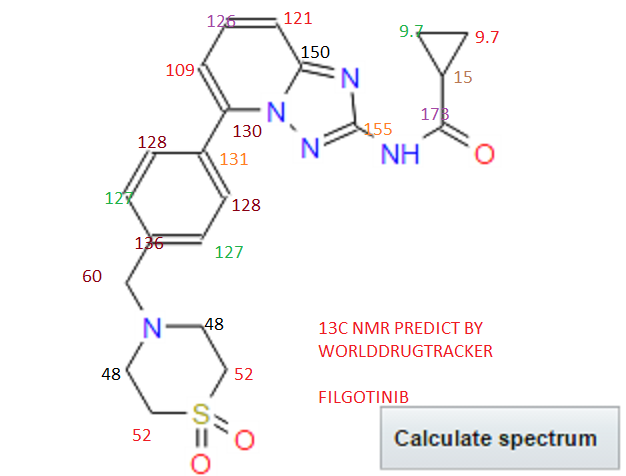
COSY
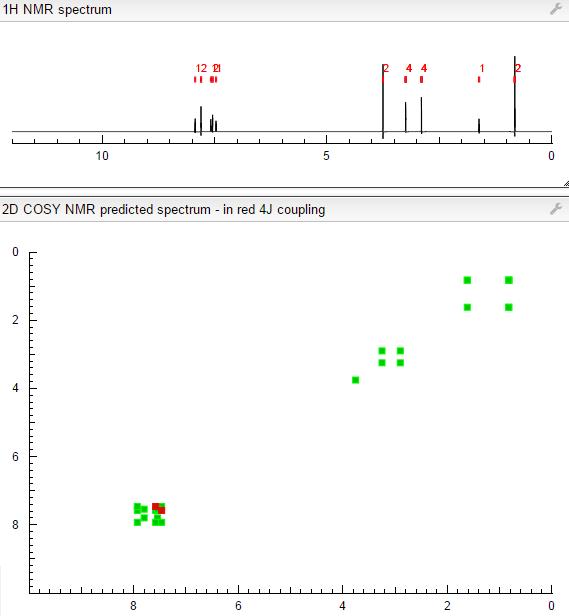
References
- Namour, Florence; Diderichsen, Paul
Matthias; Cox, Eugène; Vayssière, Béatrice; Van der Aa, Annegret;
Tasset, Chantal; Van’t Klooster, Gerben (2015-02-14). “Pharmacokinetics
and Pharmacokinetic/Pharmacodynamic Modeling of Filgotinib (GLPG0634), a
Selective JAK1 Inhibitor, in Support of Phase IIB Dose Selection”. Clin Pharmacokinet. Epub ahead of print.doi:10.1007/s40262-015-0240-z.
- Van Rompaey, L; Galien, R; Van der Aar, E;
Clement-Lacroix, P; Van der Aar, E; Nelles, L; Smets, B; Lepescheux, L;
Cristophe, T; Conrath, K; Vandeghinste, N; Vayssiere, B; De Vos, S;
Fletcher, S; Brys, R; Van’t Klooster, G; Feyen, J; Menet, C
(2013-10-01). “Preclinical characterization of GLPG0634, a selective
inhibitor of JAK1 for the treatment of inflammatory diseases”. J Immunol. 191(7). doi:10.4049/jimmunol.1201348.
- http://acrabstracts.org/abstracts/phase-1-and-phase-2-data-confirm-that-glpg0634-a-selective-jak1-inhibitor-has-a-low-potential-for-drug-drug-interactions/
- “Galapagos’ GLPG0634 shows excellent efficacy and safety in rheumatoid arthritis Phase II study” (PDF) (Press release). Retrieved 2015-02-26.
- “Galapagos reports that the last patient in DARWIN 1 has completed 12 weeks of treatment” (PDF) (Press release). Retrieved 2015-02-26.
- “Galapagos completes recruitment for Darwin 1 study with GLPG0634 (filgotinib) in RA”. EuroInvestor. Retrieved 2015-02-26.
- NASDAQ OMX Corporate Solutions. “Galapagos completes recruitment for Darwin 2 monotherapy study with GLPG0634 (filgotinib) in RA”. Yahoo Finance. Retrieved 2015-02-26.
| US8551980 |
Nov 17, 2010 |
Oct 8, 2013 |
Bayer Intellectual Property Gmbh |
Substituted triazolopyridines |
| US8796457 |
Jun 25, 2010 |
Aug 5, 2014 |
Galapagos Nv |
Compound useful for the treatment of degenerative and inflammatory diseases |
| Patent |
Submitted |
Granted |
| Compound useful for the treatment of degenerative and inflammatory diseases [US8088764] |
2010-12-30 |
2012-01-03 |
| NOVEL COMPOUNDS USEFUL FOR THE TREATMENT OF DEGENERATIVE AND INFLAMMATORY DISEASES [US2011190260] |
2011-08-04 |
|

सुकून उतना ही देना प्रभू, जितने से जिंदगी चल जाये। औकात बस इतनी देना, कि औरों का भला हो जाये।

DRUG APPROVALS BY DR ANTHONY MELVIN CRASTO …..
FOR BLOG HOME CLICK HERE
Join me on Linkedin

Join me on Facebook
 FACEBOOK
FACEBOOK
Join me on twitter

Join me on google plus
 Googleplus
Googleplus
Join me on Researchgate


amcrasto@gmail.com

LIONEL MY SON
He was only in first standard in school when I was hit by a deadly one in a million spine stroke called acute transverse mylitis, it made me 90% paralysed and bound to a wheel chair, Now I keep him as my source of inspiration and helping millions, thanks to millions of my readers who keep me going and help me to keep my son happy
सुकून उतना ही देना प्रभू, जितने से
जिंदगी चल जाये।
औकात बस इतनी देना,
कि औरों का भला हो जाये।
Read all about Organic Spectroscopy on ORGANIC SPECTROSCOPY INTERNATIONAL 
/////////Galapagos, GLPG0634, Filgotinib, PHASE 2
SMILES code: O=C(C1CC1)NC2=NN3C(C4=CC=C(CN5CCS(CC5)(=O)=O)C=C4)=CC=CC3=N2
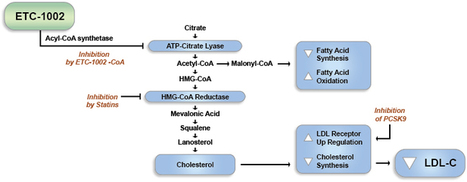




 7-Bromo-2,2-dimethylheptanoic acid ethyl ester
7-Bromo-2,2-dimethylheptanoic acid ethyl ester p- toluenesulfonyl methyl isocyanide
p- toluenesulfonyl methyl isocyanide 8-isocyano-2,2,14,14-teframethyl-8-(toluene-4-sulfonyl)-pentadecanedioic acid diethyl ester
8-isocyano-2,2,14,14-teframethyl-8-(toluene-4-sulfonyl)-pentadecanedioic acid diethyl ester  2,2,14,14-tetramethyl-8-oxo-pentadecanedioic acid diethyl ester
2,2,14,14-tetramethyl-8-oxo-pentadecanedioic acid diethyl ester 

 A PRECURSOR OF Bempedoic Acid
A PRECURSOR OF Bempedoic Acid

 Esperion
Therapeutics founder and chief scientific officer Roger Newton, left,
and CEO and President Tim Mayleben celebrate the company’s initial
public …
Esperion
Therapeutics founder and chief scientific officer Roger Newton, left,
and CEO and President Tim Mayleben celebrate the company’s initial
public …

 Esperion cofounder Roger Newton
was one of the Key players in the Development of LDL-Cholesterol
Lowering Pfizer’s statin atorvastatin (Lipitor), the Biggest Selling
Drug of All time with Annual Sales of Almost $ 13 Billion Dollars in
2006 at ITS Peak.
Esperion cofounder Roger Newton
was one of the Key players in the Development of LDL-Cholesterol
Lowering Pfizer’s statin atorvastatin (Lipitor), the Biggest Selling
Drug of All time with Annual Sales of Almost $ 13 Billion Dollars in
2006 at ITS Peak.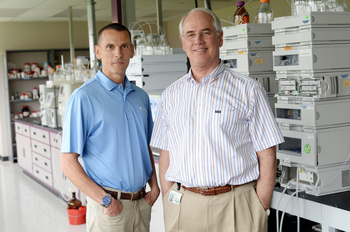
 SRI
International’s Helen Parish (from left), David Sahner and Elizabeth
Wood in November 2013 at the site of the nonprofit’s new clinical
laboratory at the Michigan Life Science and Innovation Center in
Plymouth Township.
SRI
International’s Helen Parish (from left), David Sahner and Elizabeth
Wood in November 2013 at the site of the nonprofit’s new clinical
laboratory at the Michigan Life Science and Innovation Center in
Plymouth Township. Michigan Life Science and Innovation Center
Michigan Life Science and Innovation Center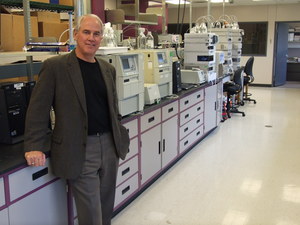 Esperion Therapeutics CEO Roger Newton in his laboratory at the Michigan Life Science Innovation Center in Plymouth Township.
Esperion Therapeutics CEO Roger Newton in his laboratory at the Michigan Life Science Innovation Center in Plymouth Township.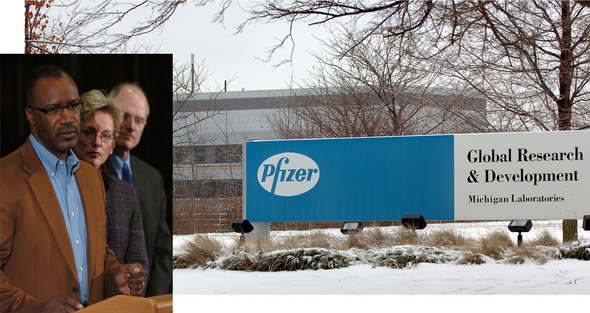 Pfizer
Inc. announced Jan. 22, 2007 that it would close its Ann Arbor research
campus on Plymouth Road and Huron Parkway. In the photo at left,
then-Ann Arbor SPARK CEO Michael Finney, then Gov. Jennifer Granholm and
Ann Arbor Mayor John Hieftje speak at a press conference addressing
Pfizer’s announcement.
Pfizer
Inc. announced Jan. 22, 2007 that it would close its Ann Arbor research
campus on Plymouth Road and Huron Parkway. In the photo at left,
then-Ann Arbor SPARK CEO Michael Finney, then Gov. Jennifer Granholm and
Ann Arbor Mayor John Hieftje speak at a press conference addressing
Pfizer’s announcement.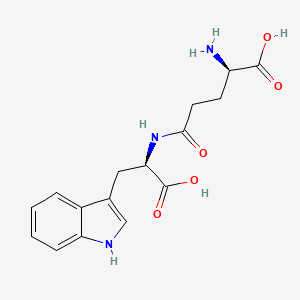

 DRUG APPROVALS BY DR ANTHONY MELVIN CRASTO …..
DRUG APPROVALS BY DR ANTHONY MELVIN CRASTO …..


 LIONEL MY SON
LIONEL MY SON


 3D
3D







































